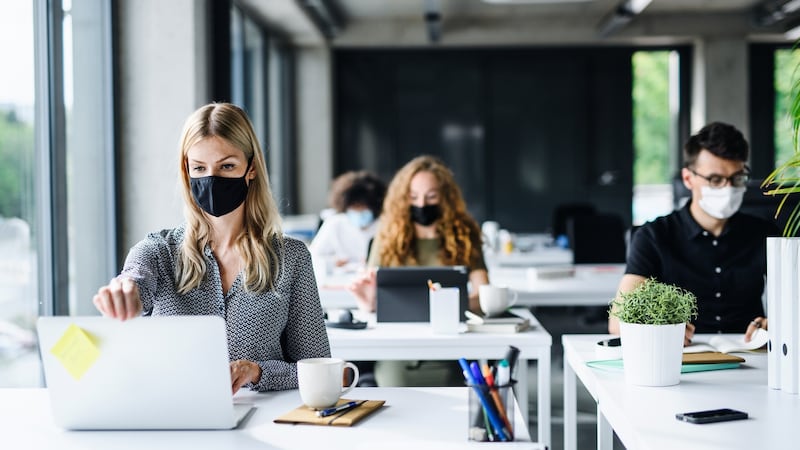Employers that already provided a degree of flexibility are finding it easier to cope with the pandemic. "Prior to Covid we had a lot of remote work flexibility, it was fairly typical for people to work from home two days a week," says Conor McDonnell, head of human resources at Fidelity Investments Ireland.
The financial services company employs 1,200 people here, of whom 900 are working in technology.
It has not yet set a date for the return to office but, given its culture, even with its ability to remote work, the office will remain important.
“Ours is a highly collaborative, relationship-driven culture. For us, the most likely prospect will be a hybrid model, but with working from home an even more embedded part of our future,” he explains.
When the time is right, Fidelity Investments will run a “safe pilot” return-to-work test, bringing in a small cohort of volunteers into the office for perhaps two weeks. “This will allow us to test our protocols and, all going well, we will build from there. But everything we do around this is voluntary.”
A huge part of managing diversity and inclusion right now is around looking after people’s concerns of health and wellbeing.
His team is investigating the kind of equipment to help, such as thermal imaging cameras and at the development of an in-office contact tracing app. “It means that if we did have a confirmed case, we’d be able to understand the contact points they may have had within the organisation. We are investigating the safest possible conditions to support a return to work,” he says.
Inclusivity is key. “We have a lot of feedback channels in place, from all hands and town hall meetings as well as surveys to assess mood. We have been learning what is on our associate’s minds, and what they need from us. As a result, we have introduced additional benefits such as Covid relief days, an extra five days’ paid leave if, for example, someone is worried about something Covid-related, or has a childcare challenge.”
Health and wellbeing
The company has extended its employee assistance programme, ramping up virtual health and wellbeing programmes.
“Every associate is different. Some want to work from home. Some want to work from the office. In our experience, most want a mix of both and I do think that this will be a big change and will inform a lot of our practices in future.” In a number of sectors, work has become what we do rather than the place we go to do it, he points out.
Three Ireland employs 1,400 people in Ireland, with a diversity of staff that includes essential workers in retail stores and office-based workers who can work from home.
“The benefits of remote working can’t be denied so, in the future, we will have a hybrid scenario giving us the best of both,” says Mark Redmond, chief people officer for Three Ireland.
It has told staff working from home that they will do so until January at the earliest. “Things are changing daily and it’s the uncertainty that is causing the most stress,” he says.
The pandemic has shown just how flexible and adaptable organisations are.
“We’ve been talking for years about needing agility, now we’ve proved we can be agile,” says Maeve Houlihan, associate dean and director of the UCD Lochlann Quinn School of Business.

She too believes people benefit from the kind of certainty that tech firms have been able to give employees about WFH until at least next year. “The benefit of it is that people can think,” she says. Without it people can feel they are in “fire-fighting” mode.
Dialogue and listening
UCD has found that about 40 per cent of its employees are comfortable with the idea of a move back to work, with the same number not feeling safe to do so. The question for employers is “how do we accommodate these different groups”, she says.
The key is to listen to what people want.
“This is a period of time, it will pass. So why not learn from it?” she asks.
Communications is key. “We tend to mix communications up with information. It’s not just about being informed, it’s about being heard, about dialogue, about listening,” she says.
“What we have learned is that we can have people working at a distance sometimes. We’ve always had it, but we know now we can do it to a greater degree. But to do that we need to be doing the connections bit better, it can’t just always be town-hall-style meetings.”
Communications must be nuanced enough to speak to those who are comfortable and uncomfortable about either working from home or returning to work. If, as an employer, you’re finding that hard, don’t worry.
“There is no rule book to this, no guidelines to follow. But we can communicate what we do know, and what we can do to reassure people around health and safety,” says Kara McGann, head of social policy at Ibec, the employers’ organisation.
Some employers are organising “walk through” videos, showing employees exactly what is happening at work, including practical steps such as showing where the sanitising stations are and what the contact-tracing procedures are.
“It’s a way of saying ‘this is how the office looks now’,” she explains. This is important because, in some cases, employees “are really looking forward to getting back to the office only for the day to come and suddenly they feel ‘Oh, hang on’,” she says. “People want to know ‘what is the plan?’ – it’s reassuring for them. It’s not enough to do an information dump. You need to make sure the message you are giving people actually answers their questions.”













